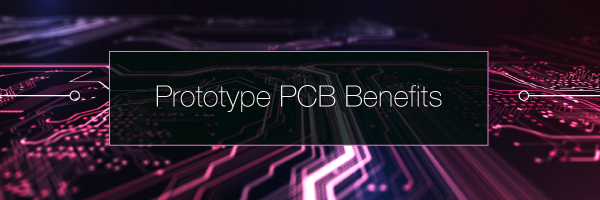
Before you begin a full production run, you need to make sure that your printed circuit board, or PCB, is functioning properly. Because PCBs are such an integral part of so many electronic devices, if one fails or performs inadequately after full production, it can be extraordinarily costly. Prototyping your PCB beforehand can help you avoid such a situation.
Engineers use prototype PCBs early in the design process to test the functions of a PCB-based solution. They often order multiple runs of prototypes to test redesigns or test a single function before moving on to a more complex design. This enables them to discover elements that require correction earlier in the process. The earlier you catch those issues, the less costly they will be.
For prototyping your PCB solutions to be effective, you need an assembler who can quickly create high-quality prototypes that align with how the final product will function as closely as possible. That's why, at PCBCart, we offer a fast, accurate prototyping service with a low minimum order quantity.
Prototype vs. Standard Production PCBs
Our prototype boards differ from our standard production boards in a number of ways. Prototypes offer fewer advanced options and lower production tolerances but will nevertheless be able to demonstrate whether your designs meet your performance and quality standards.
We offer a fast build time for prototypes. You can also order prototypes in smaller quantities of 5 to 100, while standard orders can consist of one to more than 10,000 pieces.
The specifications of these two types of boards also differ. Prototypes meet the quality standard of IPC1, while standard boards meet IPC2. Prototypes only use the material R4, while standard runs can use various materials, including R4, aluminum and flex-rigid material.
Standard PCBs can also handle a higher number of layers than a test board can. Our prototypes can accommodate up to 8 layers while the standard can have as many as 32. This means that standard can have a greater thickness than prototypes boards can. Both varieties have the same minimum, while the standard's maximum is slightly higher.
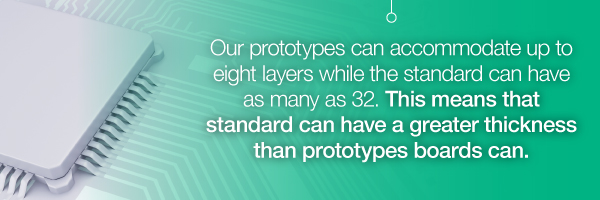
With standard boards, you also have more options for surface finish, which protects exposed copper circuitry and provides a surface to which other components can be soldered. Prototypes use either Hot Air Solder Leveling (HALS) or Electroless Nickle/Immersion Gold (ENIG) with options that adhere to restrictions of hazardous substances (RoHS) regulations.
Standard production PCBs, on the other hand, can use HALS, ENIG, Electroless Nickel, Electroless Palladium Immersion Gold (ENEPIG), Immersion Silver, Immersion Tin and Organic Solderability Preservatives (OSP).
Prototypes also lack the ability to support some more advanced features, including:
• Impedance control
• Gold fingers
• UL marking/date code marking
• Buried/Blind vias
• Peelable solder mask
• Edge plating
• Carbon Mask
• Kapton tape
• Countersink/counterbore hole
• Half-cutted/Castellated hole
• Press fit hole
• Via in pad
• Solder-stop coating bridge
Why Use a PCB Prototype?
So, why would you choose to use a PCB prototype over a standard production run? It may seem like an extra step, but in the long run it can save you time and money and result in a better final product.
When developing a new PCB-based design, you will likely go through numerous design iterations. You need to be able to quickly test new designs in order to complete production in a timely manner, as an overly long design process can result in lost revenue. The fast speed of our prototyping service combined with testing a design before committing to a full production run allows you to minimize wasted project spend and maximize your investment.
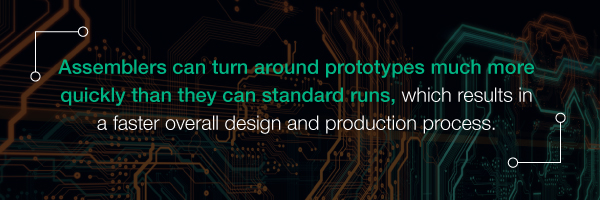
Standard production runs would also add up quickly in terms of cost. The sooner you catch design flaws or inefficiencies in your PCB design, the less costly fixing the issue will be. If you don't use a prototype board to test your design, you might not catch problems until later in the production run — that is, after you've already invested a significant amount into producing standard PCBs. Our prototyping service also lends itself well to low-volume production runs and requires a minimum of only five boards.
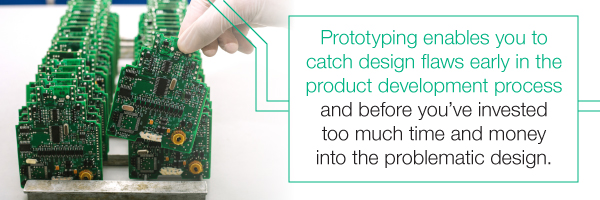
Engineers also frequently use prototype PCBs to test single functions of a more complex product that contains multiple PCBs. They will order a prototype that performs the most basic function before adding the next level of capability. If you don't test functions individually, you may encounter a performance issue later in the process and be unsure which board is causing the problem. Figuring this out could take a substantial amount of time and resources that could have been saved by gradually prototyping the individual functions.
Although prototype PCBs do not allow for manufacturing tolerances that are as high as those possible with standard production runs, they still provide an accurate portrayal of how your final PCB-based solution will work. We can manufacture prototypes that are nearly identical to what the final product would look like and how it will function, but at a lower manufacturing tolerance and without some of the more advanced features. We take great care, however, to provide prototype boards that accurately represent how your standard production PCBs would function.

Once you have completely validated your design with prototype boards, you can move on to a standard production run, which has tighter manufacturing tolerances, can handle more capabilities and can contain larger volume orders. As part of our standard production offering, we provide a Design for Manufacture analysis, which helps to identify any issues that could impact manufacturing. If we discover any potential concerns, we will contact you to develop the necessary solutions.
If you are developing a new product or redesigning, you will likely benefit from our prototype PCB production service. It will help you to spot any potential issues or changes that you may wish to make to your design before you invest significant amounts of time and money into the project. This will improve your project's bottom line, result in a higher-quality final product and contribute to its overall success.
PCB Prototype Advantages
Choosing to order PCB prototypes rather than going straight to a standard production run offers a number of advantages. In almost any situation that involves a new or updated design, PCB prototyping can prove to be beneficial. The advantages of using our PCB prototyping service include:
• Fast Turnaround Time: We can produce PCB prototypes significantly more quickly than we can standard production PCBs. We can turn around an order for prototypes in as little as two days. Our build time for standard production boards is three to 18 days, while our prototype build time is just two to five days. This quick turnaround means you can begin testing new designs more quickly and keep your project moving at a sufficient pace.
• Ability to Detect Flaws Early: Prototyping enables you to catch design flaws early in the product development process and before you've invested too much time and money into the problematic design. Making engineering changes early on in the process will avoid a range of potential issues that could impact various areas of your project. Fixing an issue later in the process will be more complicated and could be more costly.
• Ability to Test Components Individually: For complex projects that involve multiple PCB-based components, individually testing the different parts is immensely useful. Validating each component individually enables you to pinpoint where any issues might be occurring. Without this, it would be difficult to determine where the problem was. You would then have to order another whole multi-PCB component or begin to break it down into individual pieces. Doing this from the beginning of the process is much more efficient.
• Accurate Representation of Standard PCB Performance: Quality PCB prototypes provide an accurate representation of how your final production component will perform. Despite the lower tolerances, they still give you a good idea of what to expect when you begin a standard production run.
• Efficient Project Completion: Using PCB prototypes enables you to spot and correct design flaws early on and quickly pinpoint which components you need to adjust. Without prototyping, uncovering flaws and the causes of inadequate performance would be much more time-consuming and could substantially extend a project's timeframe, potentially resulting in lost revenue and dissatisfied customers.
• Reduced Overall Costs: Prototyping can also reduce the overall cost of a project, as well. By helping you to catch issues sooner, it enables you to fix them before you invest in a high-volume standard production run. By identifying problems in a simpler version of your product, you can rework that simpler component rather than having to produce the entire project, which would be much more expensive.
• Improved Final Product: PCB prototyping facilitates a focus on perfecting each PCB and component, which can result in a higher-quality design. It also helps you avoid any undetected malfunctions that could show up in final products and cause more significant problems further down the line.
Because of the benefits that the prototyping of PCBs offers, it's recommended for the vast majority of cases that involve a new or revised PCB design. Once you've taken advantage of what the prototypes have to offer the project, you can move on to standard production runs.
PCB Prototype Applications
Printed circuit boards, which connect components through various related circuits, are at the heart of the many different electronic devices that we use every day. They come in many different variations, which allows them to perform under a wide range of circumstances. PCBs are an integral part of electronics used across nearly every industry. You can find them in consumer electronics, medical devices, automotive components, industrial equipment, lighting technologies, aerospace instrumentation and much more.
As people continue to innovate and create more new electronic devices, PCBs become even more common. It is in the development of these new products that prototype PCBs are most useful. You should consider prototyping if your project involves any of the following conditions:
• New products - Any time your project involves developing a new product, you should use PCB prototyping. Without prototyping, you may not detect any existing issues before they cause more severe problems or become more difficult to fix. Even if your project is very similar to another that you've already successfully completed, prototyping can be helpful. Many different factors go into a device's performance and prototyping enables you to quickly and economically identify any of those factors you need to adjust.
• Quality and design testing - If you want to perform quality testing or design review, you should order PCB prototypes. The shorter build time will allow you to begin conducting your review or testing sooner and will reduce your overall costs. PCB prototypes will give you an accurate idea of how your final product will perform. They enable you to verify quality and performance before you invest in a larger standard production run, helping you to complete your project quicker or most cost-effectively.
• Complex components - If your project contains multiple PCB-based components, you should use PCB prototypes. More components can mean more functionality but also more potential failures. With these more complex projects, prototyping is especially useful, as it helps to quickly identify which component is not performing correctly. You'll spend less time testing and correcting problems that arise and save money by ordering one PCB at a time.
• Modeling purposes - If you want to present your physical design but don't need the board to function, you should use a prototype. In some situations, you may wish to have a model of your design to illustrate how it will work. In these cases, you don't need a fully functioning board. You only need an accurate representation of the design. Using a prototype for this visual can be a more cost-effective option than using a standard production board.
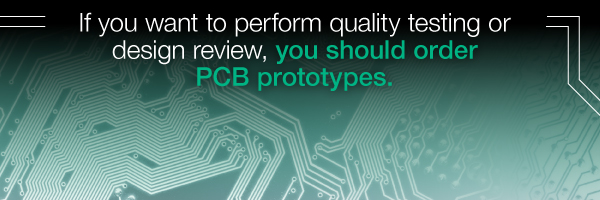
PCB Prototype Options
In different situations, you might need different things from your prototypes. There are several different kinds of prototypes. The right one for you will depend on what you plan to use it for. During the course of a single project, a development team will often use multiple types of prototypes:
• Visual Model: When you just want to illustrate the physical aspects of your design, you will likely use a visual model prototype. Visual models match the physical aspects of your final product but do not function. They are useful for demonstrating and reviewing your design in an affordable way.
• Proof-of-Concept Prototype: Use a proof-of-concept prototype to show that the concept of your design is viable. It will include some of the capabilities of the final product but might not include all of them, since it only needs to include enough to show that the idea will work.
• Working Prototype: This kind of prototype is a functioning board and contains all of the functionalities planned for the final product. The design could still be changed before the final standard production run, though, so it might not necessarily represent an exact replica of the finished product.
• Functional Prototype: A functional prototype is designed to be as close to the final version of the component as possible to provide an accurate idea of how the design will work in standard production. This prototype should include all characteristics and capabilities planned for the final iteration that are feasible for the prototype run. A functional prototype may have some slight variations as compared to the final product. For instance, it might use a different material, lower manufacturing tolerances and be assembled using different equipment.
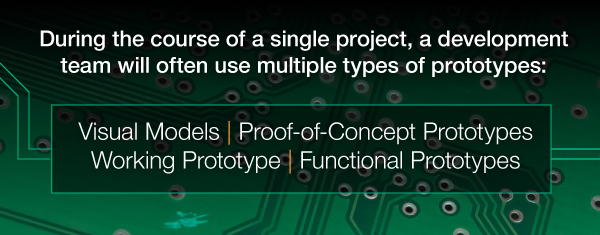
Engineers may start with a visual model or proof-of-concept design before moving to a working prototype and a functional one. Since these variations become more functional and closer to the final product as they go, they can follow this progression to streamline the design validation process. They start off proving their basic concept and then progressively add and validate more functionality. That way, if there are any problems with the basic design, they can fix them before moving into the next step. This is more efficient than having to come back and fix those issues later on in the development process.
Ordering PCB Prototypes From PCBCart
At PCBCart, we act as a one-stop shop for all of your PCB prototyping and standard production needs. We can complete every part of the prototyping process — including component procurement, fabrication, assembly and quality control. This saves you from having to work with multiple suppliers and makes the process more efficient and economical.

We focus on quality as well as following your design specifications down to the smallest detail. We won't make any changes without obtaining your approval and will work with you to correct any issues that come up. We also offer quick customer service response times and personalized service that sets us apart from others in the industry. Please https://www.pcbcart.com/company/contact-us.html or for more information.

We also offer an easy-to-use online quote calculator for our custom PCB prototyping and production. Just input your specifications and the items you need and we will generate a free quote for you.
Get PCB Prototyping Price online
Request PCB Assembly Prototyping Quote
If your project is better suited for standard PCB production, you can also request a standard PCB manufacturing quote instead!
For more information on standard vs. prototype PCB orders, check When to Use PCB Prototype Service and When to Switch to Standard Production Service.


















